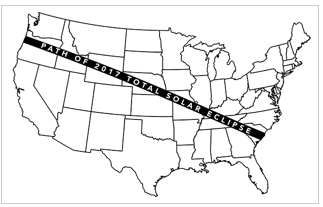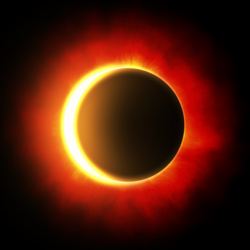For those who live in a specific corridor between the Pacific Northwest and the Atlantic Southeast, get set to experience a breathtaking celestial event that hasn't occurred in nearly a century.
That's when night will interrupt day for a couple minutes.
In less than two months time, the entire continental United States will witness a total eclipse of the sun, the first time that will happen in 99 years, according to a NASA officials in public statements released yesterday. The event will take place on August 21, when those living in a 70-mile-wide band between Oregon and South Carolina will be able to watch the moon completely block out the sun (adjacent graphic courtesy of NASA) while providing them a rare, naked-eye glimpse of the burning star's solar corona.
 For those in this band, the total eclipse of the sun will last for up to 2 minutes and 40 seconds, depending on one's specific location, while the entire continent will be treated to a partial eclipse lasting between two and four hours.
For those in this band, the total eclipse of the sun will last for up to 2 minutes and 40 seconds, depending on one's specific location, while the entire continent will be treated to a partial eclipse lasting between two and four hours.
In addition, what makes this total eclipse extra special is that the space agency will be able to record the spectacular occurrence in unprecedented ways.
“Never before will a celestial event be viewed by so many and explored from so many vantage points – from space, from the air, and from the ground,” said Thomas Zurbuchen, associate administrator of NASA’s Science Mission Directorate, in a statement, which added that "[v]iewers around the world will be provided a wealth of images captured before, during, and after the eclipse by 11 spacecraft, at least three NASA aircraft, more than 50 high-altitude balloons, and the astronauts aboard the International Space Station – each offering a unique vantage point for the celestial event."
For an extremely cool interactive map of the "path of totality" of the eclipse, courtesy of NASA, click here. You can zoom in and see precise locations that will – and won't – experience the total sun blackout. (Again, it's really cool).
 The solar corona is the sun's outer atmosphere, a rarely-seen and stunning sight that won't pose a threat to an observer's vision. Meanwhile, NASA informs us, 'it’s safe to look at the total eclipse with your naked eyes only during the brief period of totality."
The solar corona is the sun's outer atmosphere, a rarely-seen and stunning sight that won't pose a threat to an observer's vision. Meanwhile, NASA informs us, 'it’s safe to look at the total eclipse with your naked eyes only during the brief period of totality."
That said, take note: It is unsafe to view the partially eclipsed sun. Specifying the need for certified "eclipse glasses" – which can be purchased – and other viewing devices, NASA warns:
"Do not look at the uneclipsed or partially eclipsed sun through an unfiltered camera, telescope, binoculars, or other optical device. Similarly, do not look at the sun through a camera, a telescope, binoculars, or any other optical device while using your eclipse glasses or hand-held solar viewer — the concentrated solar rays will damage the filter and enter your eye(s), causing serious injury." Click here for detailed safety instructions and further guidance.
Aug. 21 promises to be a special day, and one that – as far as the continental U.S. is concerned – may never occur again in our lifetimes. So mark it on your calendar.
And then hope, when that day arrives, that the weather in your area cooperates.

